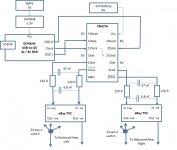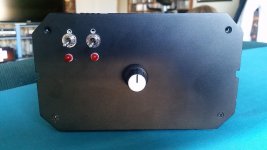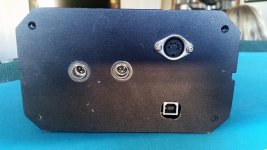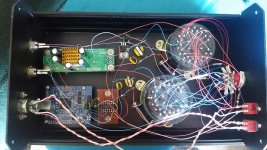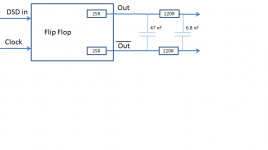Hi Chris,
Link to the idea: PureDSD
R1 & C1 does the Low Pass Filter, values depend of the frecuency cutoff do you want, for example I use 1K 3.3nF Cut-off frequency fc = 48228.770633908[Hz]
Here you have a calculator so you can use the cutoff frecuency that you want (Sample)RC Low-pass Filter Design Tool - Result -
Link to the idea: PureDSD
R1 & C1 does the Low Pass Filter, values depend of the frecuency cutoff do you want, for example I use 1K 3.3nF Cut-off frequency fc = 48228.770633908[Hz]
Here you have a calculator so you can use the cutoff frecuency that you want (Sample)RC Low-pass Filter Design Tool - Result -
Hi
I am interested in build up a converter as you discribed,
PC - USB - "Best DAC is no DAC" - Preamp (XLR) -LS
i go throug a lot of pages put is it possible to get a summary of all latest parts and /or i kind of material of quantity (MoQ)
chris
What USB device do you have? Several of us here have achieved good results using the JLSounds USB board.
Are you looking for single-ended or differential output?
Several options for implementation. Hazard uses some Lundahl transformers to good affect - see post #1. You can also use an RC low pass filter, which is a quick and cheap way of trying the approach out - see merlin's post immediately previous to this one.
If you're interested in the RC approach I have some PCBs available (or will have as soon as they arrive) that piggy back onto the JLSounds board if you want to give it a try?
http://www.diyaudio.com/forums/digital-line-level/273474-best-dac-no-dac-166.html#post4939270
Ray
Last edited:
For those waiting for PCBs, they arrived this morning. I'll aim to get them posted out to you on Monday or Tuesday.
Ray
Ray
..i am a noob
Hi
Now i am starting to interest more in DAC or no DAC to get some experiance with the target of better sound.
i use a laptop (i5 Dell Vostro) over foobar or jRiver(actually a test version) --> USB to my Reclocker -Mutec MC3+ --> DAC is a Mytek Brooklyn (or TEAC ud301)---> then with XLR cabel to my amps - Ls are open baffle
chris
Hi
Now i am starting to interest more in DAC or no DAC to get some experiance with the target of better sound.
i use a laptop (i5 Dell Vostro) over foobar or jRiver(actually a test version) --> USB to my Reclocker -Mutec MC3+ --> DAC is a Mytek Brooklyn (or TEAC ud301)---> then with XLR cabel to my amps - Ls are open baffle
chris
Link to the idea: PureDSD
Any thoughts on Andrea's update from November last year?:
Update Nov. 2016: After many test I was not able to completely eliminate the digital noise on output also using separated power supply for the Amanero and also using isolator on I2S bus so I don't suggest this project.
Is there something we could still do or would there be a need to do an alternate layout for a board like that or else source another board completely?
NB: I'm not saying this is only Amanero-related. There could be issues with other boards as well: this is after all something which is mixed signal, and the DSD part is really, really high speed.
Any thoughts on Andrea's update ...
I don't know of an inherent reason for the noise issue, other then high frequency quantisation noise, which is what we are trying to filter out.
My thoughts are still that the noise has something to do with isolation, artifects from the PSU or clocking.
What else is there, what did I miss?
Quick Update:
1. I removed my passive pre-amp from the signal path. Did it make an improvement? I'd be hard pressed to say that I heard a difference. I will settle with the observation that the TVC does a great job and sounds very transparent.
2. I bypassed the Lundahls and took the flip flop output direct to the TVC input. Outcome - I found lots of noise, just like Ray did, when he connected directly to his Silk TVC. What is going on here?
First hypothesis is that Lundahl has a lower f3 (more input capacitance) than the new TVC, and is acting as an (expensive) LPF. However, the noise is very wide band width. It is not hf noise, more like white noise and is quite obvious even in my midrange/woofer (which operates from 650 Hz down). And during quiet parts (eg fade in / fade out) there are whoosing type artefacts. Very strange.
I am upsampling to DSD256 so i would expect any DSD noise to be very hf so this is quite unexpected. I went back and re-added the Lundahl between the flip flop and TVC. Noise is gone again. So - the first hypothesis appears correct. But the Lundahl cannot be filtering noise that is within the audio range, and leaving the music behind. So second hypothesis - the upsampling process creates lots of HF noise which combines with audio signal to create intermodulation distortion (noise) in the audio range. So - I need to build a LPF and test this hypothesis.
The TVC has quite low DCR on the input (12 ohm) so I don't want to make an RC filter because it will attenuate the signal. Luckily i recently bought a few 10mH common mode chokes for use in power supply filters, these have DCR about 0.4 ohms, so I can make a balanced LPF with one of these between FF and TVC. Maybe next weekend.
On a final note - DIYINHK has just released a new USB to I2S board, isolated and capable of DSD512. The JLSounds only does DSD256, so i might get one of these try it out. Hopefully it will push the noise up so far that I can't hear the intermodulation artefacts!
Isolated XMOS 768kHz DXD DSD512(DSD1024) high-quality USB to I2S/DSD PCB - DIYINHK
Hi everyone, it's been a while since I said 'Maybe next Weekend". Not as long as a John Lennon weekend by any means, but long enough. (Since I last posted I have playing around with cartridges, I bought a Lyra MC cartridge, and a Decca Gold, and been having fun comparing them on my Lenco 😀).
Anyway, finally got around to making some changes as discussed above. I bought the DIYINHK USB board. I also built a LPF as I threatened to do. Here is my summary.
1. My PC hasn't got enough guts to upsample 8x. So I am continuing with 4x till I upgrade my CPU. As far as I can tell, not much difference between JLSounds and DIYINHK at 4x.
2. I tried a passive 1st order LPF between the flip flop and TVC. Still some noise evident at fade in and fade out of songs. So I have now gone to 2nd order filter. F3 = 40k, and there is enough attenuation - I can't hear any DSD noise above the roar of the CPU fan.
3. I am happy with what I am hearing. Until I can upgrade PC, my no-DAC DAC will look like this. Not quite as simple as I wanted it to be, but as simple as I can make it.
4. While this is as good as I have heard digital - I still prefer records.
Note - my phono RIAA amp has adjustable gain, which I use a volume control. So I no longer have any pre-amp in my system, just a source selector (DP/DT switch). I think I have reached a point now where I can't simplify any more. So now I can relax for a while and enjoy some music.
Attachments
Last edited:
Hi everyone, it's been a while since I said 'Maybe next Weekend". Not as long as a John Lennon weekend by any means, but long enough. (Since I last posted I have playing around with cartridges, I bought a Lyra MC cartridge, and a Decca Gold, and been having fun comparing them on my Lenco 😀).
Anyway, finally got around to making some changes as discussed above. I bought the DIYINHK USB board. I also built a LPF as I threatened to do. Here is my summary.
1. My PC hasn't got enough guts to upsample 8x. So I am continuing with 4x till I upgrade my CPU. As far as I can tell, not much difference between JLSounds and DIYINHK at 4x.
2. I tried a passive 1st order LPF between the flip flop and TVC. Still some noise evident at fade in and fade out of songs. So I have now gone to 2nd order filter. F3 = 40k, and there is enough attenuation - I can't hear any DSD noise above the roar of the CPU fan.
3. I am happy with what I am hearing. Until I can upgrade PC, my no-DAC DAC will look like this. Not quite as simple as I wanted it to be, but as simple as I can make it.
4. While this is as good as I have heard digital - I still prefer records.
Note - my phono RIAA amp has adjustable gain, which I use a volume control. So I no longer have any pre-amp in my system, just a source selector (DP/DT switch). I think I have reached a point now where I can't simplify any more. So now I can relax for a while and enjoy some music.
What is "EBAY TVC"? Where I can byu it? Link please.
4. While this is as good as I have heard digital - I still prefer records.
Cool update.
Don't give up on it though. I have had tremendous SQ results with a Linear Regulated PSU for my DAC and using a custom USB Connection with isolation.
One thing I would try is replacing that SMPS by a Linear one or battery too.
Check Post #1582 in this thread.What is "EBAY TVC"? Where I can byu it? Link please.
http://www.diyaudio.com/forums/digital-line-level/273474-best-dac-no-dac-159.html#post4833411
A picture is worth a thousand words. Or 3 thousand words in this case.Anyway, finally got around to making some changes as discussed above. I bought the DIYINHK USB board. I also built a LPF as I threatened to do. Here is my summary.
1. My PC hasn't got enough guts to upsample 8x. So I am continuing with 4x till I upgrade my CPU. As far as I can tell, not much difference between JLSounds and DIYINHK at 4x.
2. I tried a passive 1st order LPF between the flip flop and TVC. Still some noise evident at fade in and fade out of songs. So I have now gone to 2nd order filter. F3 = 40k, and there is enough attenuation - I can't hear any DSD noise above the roar of the CPU fan.
3. I am happy with what I am hearing. Until I can upgrade PC, my no-DAC DAC will look like this. Not quite as simple as I wanted it to be, but as simple as I can make it.
4. While this is as good as I have heard digital - I still prefer records.
DAC Front - one power switch is for USB board, and one power switch for the flipflop. And one knob for the 2-deck volume switch.
DAC Rear. Power socket, USB input, and 2 mini-XLR sockets for the output.
DAC inside - the TVCs take up most of the space!
Attachments
Hi everyone, it's been a while since I said 'Maybe next Weekend". Not as long as a John Lennon weekend by any means, but long enough. (Since I last posted I have playing around with cartridges, I bought a Lyra MC cartridge, and a Decca Gold, and been having fun comparing them on my Lenco 😀).
Anyway, finally got around to making some changes as discussed above. I bought the DIYINHK USB board. I also built a LPF as I threatened to do. Here is my summary.
1. My PC hasn't got enough guts to upsample 8x. So I am continuing with 4x till I upgrade my CPU. As far as I can tell, not much difference between JLSounds and DIYINHK at 4x.
2. I tried a passive 1st order LPF between the flip flop and TVC. Still some noise evident at fade in and fade out of songs. So I have now gone to 2nd order filter. F3 = 40k, and there is enough attenuation - I can't hear any DSD noise above the roar of the CPU fan.
3. I am happy with what I am hearing. Until I can upgrade PC, my no-DAC DAC will look like this. Not quite as simple as I wanted it to be, but as simple as I can make it.
4. While this is as good as I have heard digital - I still prefer records.
Note - my phono RIAA amp has adjustable gain, which I use a volume control. So I no longer have any pre-amp in my system, just a source selector (DP/DT switch). I think I have reached a point now where I can't simplify any more. So now I can relax for a while and enjoy some music.
2nd order low pass filter attached schematic
R1 & R2 220R
C1 47nF
C2 6.8nF
Attachments
Last edited:
@hazard500
Your USB-I2S is isolated?
Yes, isolated board.
Isolated XMOS 768kHz DXD DSD512(DSD1024) high-quality USB to I2S/DSD PCB - DIYINHK
I have purchased 3 USB boards from DIYINHK over the last 2 years as my design has evolved. All have worked just fine and I don't hesitate to use their products. I also bought a 3.3V regulator from DIYINHK to power the clean side of the USB. Dirty side is powered from USB. (JLSounds board has a jumper to allow dirty side to be powered from USB or from a separate supply. DIYINHK does not have this option).
Yes, this is a 2nd order LPF but not the one I am using. Note that the flip flop has a finite output impedance, I estimate it to be 50ohms based on my experiments with 1st and 2nd order filters and perceived roll off. This impedance is very much part of the filter, though it is not shown explicitly on my circuit diagram. And don't forget - my filter is balanced and differential.2nd order low pass filter attached schematic
R1 & R2 220R
C1 47nF
C2 6.8nF
Attachments
Last edited:
Thanks for the suggestions.Cool update.
Don't give up on it though. I have had tremendous SQ results with a Linear Regulated PSU for my DAC and using a custom USB Connection with isolation.
One thing I would try is replacing that SMPS by a Linear one or battery too.
Regarding the PS for USB board - there is a small error on my schematic. The external power supply is 12V SMPS (which also charges the SLA battery). Inside the no-DAC, the 12 V line feeds a (noisy) 7805, which cascades into a low-noise 3.3V regulator, both are visible in my picture in earlier post. Do you think that the 2 linear regs in series will undo the evils of the SMPS? I also thought about inputting 6V battery power directly to the 3.3V reg, but I think that this will undo the goodness of the battery - a chain is only as good as its weakest link - is there any advantage to providing battery power to the USB board if it is subsequently regulated?
1.0uV Ultralow noise DAC power supply regulator 3.3V 5.0V 800mA - DIYINHK
I see that your USB cable is custom. Are there any commercial equivalents? And if the USB board already has isolation, is there any advantage to additional isolation? I mean, most of the processing is already done in the computer using dirty computer SMPS, a little bit more on the USB is not going to hurt - as long as it is then isolated and re-clocked before it goes to the flip flop. IMHO, anyway.
Regards, Hazard
All wires are working like a transmitting antenna but especially receptive antenna.
A best audio device and in special a DAC must be as compact as possible to minimize the incoming noise. At the same time, shielding is mandatory for a demanding solution.
A metal box will not mean necessary shielding.
Contrary to this rule almost all the projects done by enthusiastic people are made using a lot of long wires and connectors and very few are really shielded.
Is really funny how many time and money are invested to improve by 1-2 dB the signal to noise ratio, but simpler and cheaper solutions are not used.
Maybe because that the shielding and short wires are not an audiophile solution ?!?
A best audio device and in special a DAC must be as compact as possible to minimize the incoming noise. At the same time, shielding is mandatory for a demanding solution.
A metal box will not mean necessary shielding.
Contrary to this rule almost all the projects done by enthusiastic people are made using a lot of long wires and connectors and very few are really shielded.
Is really funny how many time and money are invested to improve by 1-2 dB the signal to noise ratio, but simpler and cheaper solutions are not used.
Maybe because that the shielding and short wires are not an audiophile solution ?!?
Last edited:
flip flop boards
hiya ray,
my boards arrived this morning. really great looking boards too! funny enough my amanero turned up in the post at the same time! nearly got all the parts together to start my build.
many thanks for sorting the boards out, very much appreciated.
gray 🙂
hiya ray,
my boards arrived this morning. really great looking boards too! funny enough my amanero turned up in the post at the same time! nearly got all the parts together to start my build.
many thanks for sorting the boards out, very much appreciated.
gray 🙂
- Home
- Source & Line
- Digital Line Level
- The Best DAC is no DAC
